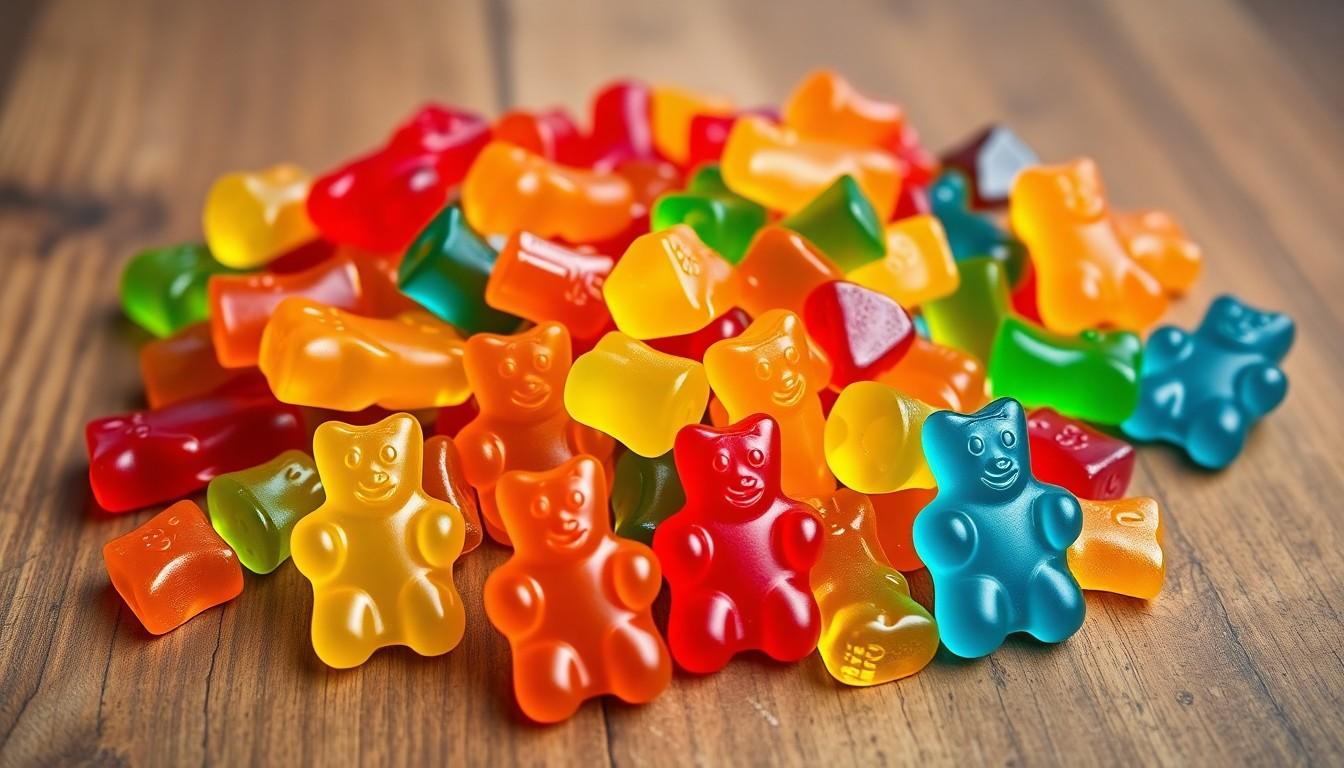When it comes to satisfying a sweet tooth, few treats can compete with the delightful charm of Haribo gummy bears. These colorful little critters have captured hearts (and taste buds) around the globe, making them a staple in candy aisles everywhere. But while they may be cute and chewy, what’s lurking behind that sugary facade?
In a world where health-conscious choices are all the rage, knowing the nutrition behind these beloved bears can be a game-changer. Are they a guilt-free indulgence or just a sugary trap in disguise? Let’s dive into the gummy bear universe and uncover the sweet truth about their nutritional value. After all, who wouldn’t want to enjoy their favorite candy while still keeping an eye on their health?
Table of Contents
ToggleOverview of Haribo Gummy Bears
Haribo gummy bears are a popular candy choice enjoyed by many. These chewy, colorful treats come in a variety of flavors, creating an appealing assortment for consumers. Each serving of gummy bears offers a blend of sweetness and texture that attracts both children and adults.
Typically, a single serving consists of about 17 gummy bears, which provides a quick source of energy. The nutritional profile includes approximately 100 calories, with 22 grams of carbohydrates. Sugar content tends to be notable at around 16 grams per serving, contributing to their sweet flavor.
While gummy bears lack significant vitamins or minerals, they do provide a delightful treat in moderation. These candies predominantly consist of sugar, glucose syrup, and gelatin, which creates their iconic chewy consistency. Citrus and fruit extracts add flavor, enhancing the overall taste experience.
In terms of dietary considerations, Haribo gummy bears contain no fat or cholesterol, making them a low-fat snack option. However, consumers should remain mindful of the high sugar content. A single serving provides enough sweetness to satisfy cravings but should be enjoyed as an occasional indulgence.
For those with dietary restrictions, reviewing the ingredient list remains essential. Some flavors contain artificial colors and flavors, which may not suit everyone’s preferences. Overall, Haribo gummy bears serve as a fun treat, with their nutritional value emphasizing moderation in consumption.
Nutritional Information

Haribo gummy bears offer a playful snack option with specific nutritional details. Understanding the values helps in making informed choices about consumption.
Calories and Serving Size
Each serving of Haribo gummy bears consists of about 17 pieces, totaling approximately 100 calories. This portion means each gummy bear has about 5.9 calories. With 22 grams of carbohydrates per serving, the primary energy source comes from sugars, which account for roughly 16 grams. Moderation remains essential to avoid excess calorie intake despite the appealing taste and texture of these candies.
Key Nutrients
Gummy bears provide negligible vitamins and minerals, contributing less than 1% of daily nutrient needs. They are low in fat with about 0 grams and cholesterol-free, appealing to those monitoring these dietary components. The sugar content stands out at 16 grams, representing a significant part of a daily sugar limit, particularly for those managing sugar intake. Ingredients include corn syrup and gelatin, which add to the chewy consistency but offer little in the way of nutritional benefits. Reading the ingredient list helps those with dietary restrictions identify any artificial additives.
Ingredients and Composition
Haribo gummy bears consist of a blend of ingredients that contribute to their signature taste and texture. Understanding this composition helps assess their nutritional value.
Sugar and Sweeteners
Sugar plays a significant role in the flavor profile of gummy bears, accounting for roughly 16 grams per serving. The primary sweetener, corn syrup, adds to the overall sweetness while enhancing chewiness. Glucose syrup also appears in the ingredient list, providing a smoother texture. Gummy bears may include other sweeteners like citric acid, which contributes tartness. Since high sugar content exists, consumption should be mindful to enjoy them as an occasional treat rather than a everyday snack.
Other Ingredients
Gelatin gives gummy bears their chewy consistency, originating from animal sources. This ingredient helps form the iconic shape and texture that fans adore. Corn starch also appears, serving as a thickening agent to ensure stability during production. Natural flavors, such as fruit essences, impart distinctive tastes like raspberry and lemon. In addition to these, artificial colors may be present, offering vibrant hues that appeal to consumers. Considering dietary restrictions is vital, so checking ingredient labels provides clarity for those with sensitivities.
Health Considerations
Haribo gummy bears may be a delightful treat, but several health considerations come into play when enjoying them.
Allergens and Dietary Restrictions
Allergens present in Haribo gummy bears can pose risks for certain individuals. Gelatin, derived from animal sources, might be unsuitable for vegetarians or vegans. Additionally, some gummy bear flavors include artificial colors and flavors, which may cause sensitivities in some people. Further, cross-contamination with gluten or nuts can occur during manufacturing. Therefore, individuals with dietary restrictions must carefully review ingredient lists before consuming gummy bears. Those who prioritize their dietary needs should seek out options specifically labeled as allergen-free.
Moderation and Sugar Intake
Moderation plays a crucial role in enjoying gummy bears. A typical serving of 17 pieces contains about 16 grams of sugar, significantly contributing to daily sugar intake. Excessive sugar consumption can lead to health issues such as obesity and diabetes. The American Heart Association recommends limiting added sugars to about 6 teaspoons for women and 9 teaspoons for men daily. Enjoying gummy bears in moderation allows for satisfying cravings while minimizing health risks associated with high sugar intake. Finding a balance can ensure that these treats remain an occasional delight rather than a regular habit.
Haribo gummy bears can be a delightful treat for candy lovers. Their chewy texture and variety of flavors make them a popular choice worldwide. However it’s essential to approach them with mindfulness due to their high sugar content and lack of significant nutritional benefits.
Moderation is crucial for those looking to enjoy these sweet snacks without compromising their health. By being aware of ingredients and potential allergens individuals can make informed decisions that align with their dietary needs. Ultimately Haribo gummy bears can fit into a balanced lifestyle when enjoyed responsibly.




